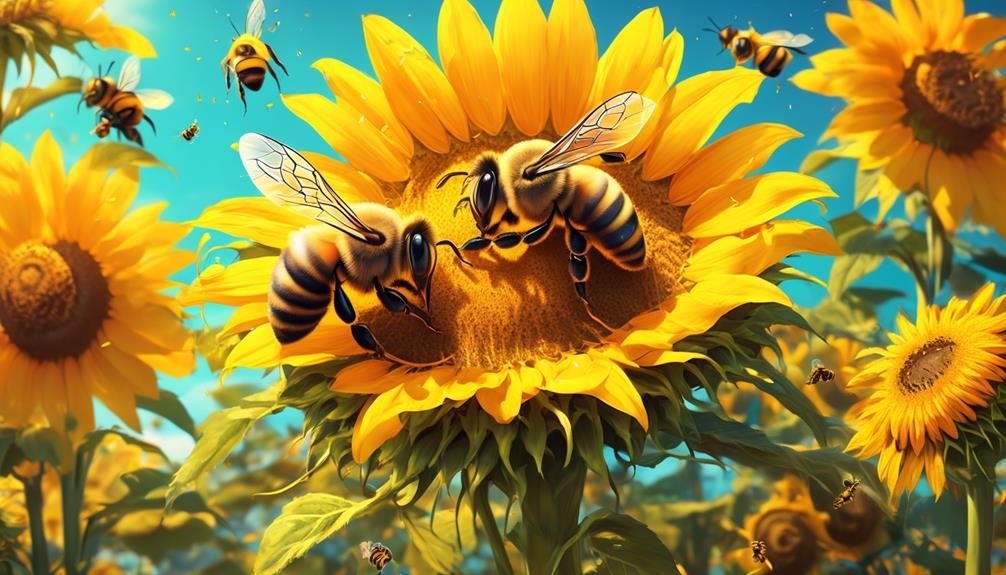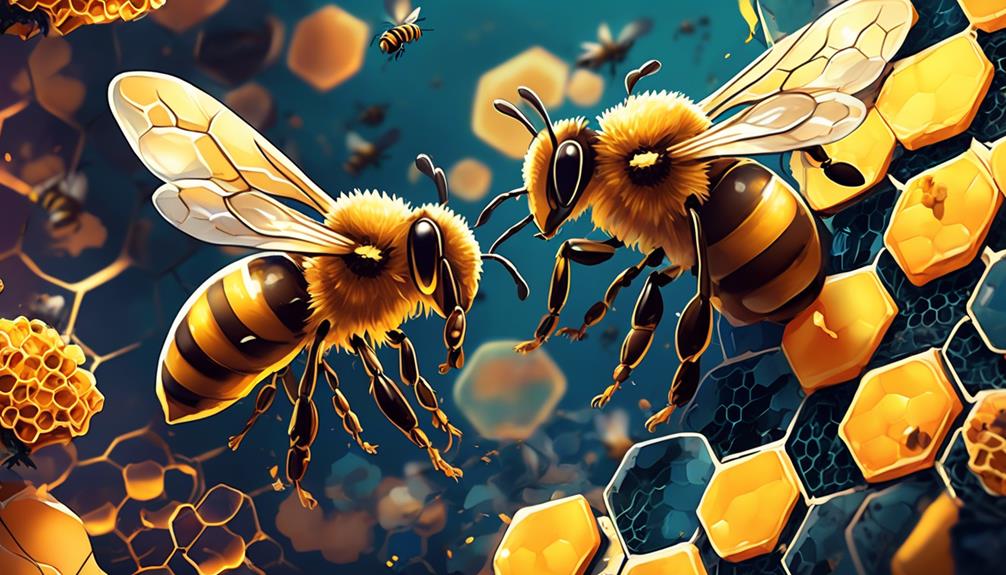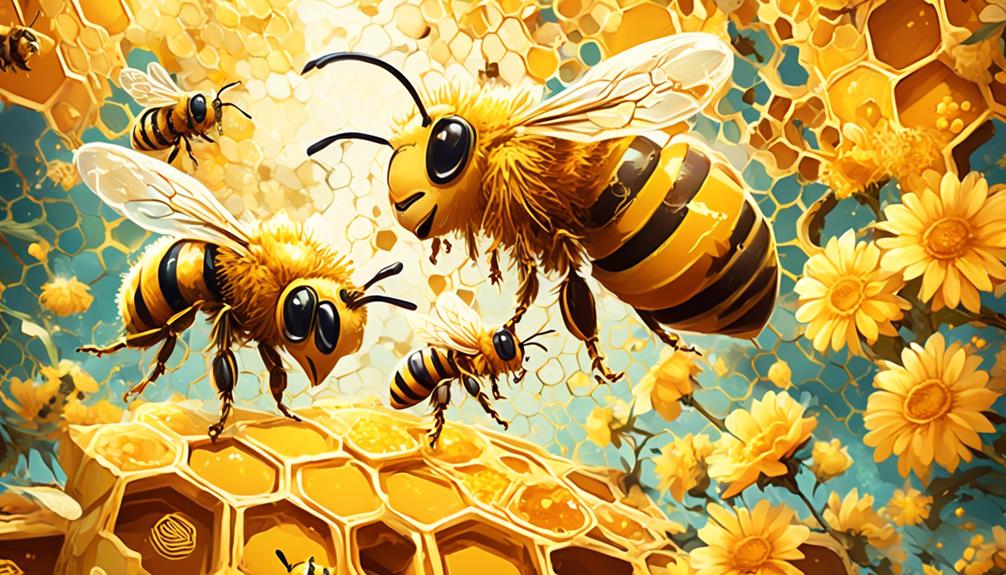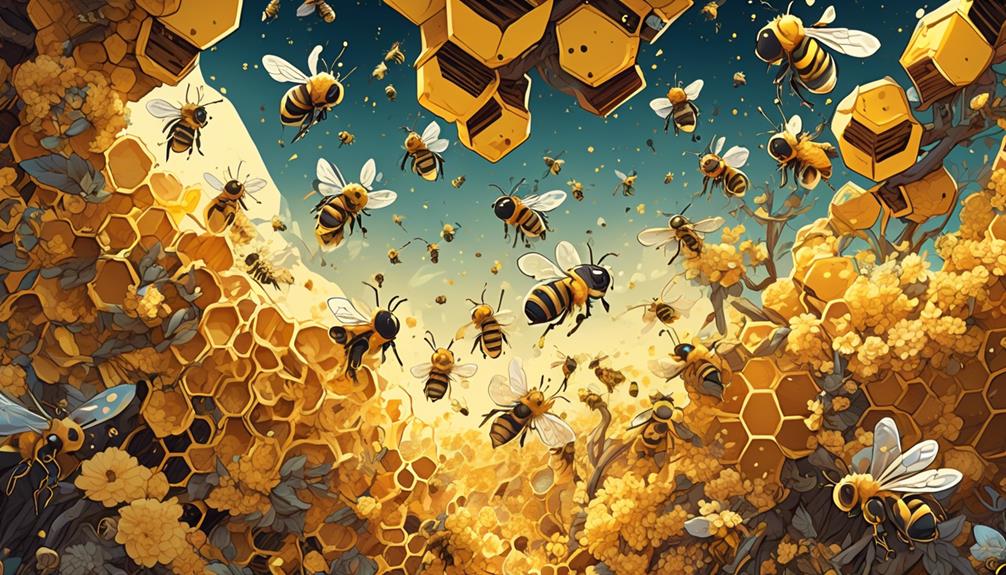An exploration into the fascinating world of bee communication, uncovering their unique methods of 'talking' through dances, chemical signals, and buzzing sounds.

Can Bees Talk?
You've heard birds chirping, dogs barking, and cats meowing, but have you ever stopped to ponder if bees can talk? Certainly, they can't engage in conversation like humans do, nor do they use audible language like many animals. However, their modes of communication are far more intriguing and complex than you might think.
Intricate dances, subtle chemical signals, and nuanced buzzing sounds all contribute to a language system uniquely suited to these tiny, industrious creatures. So, while bees might not 'talk' in the conventional sense, their communication strategies warrant a deeper exploration.
Are you ready to uncover the silent language of bees?
Key Takeaways
- Bees have complex communication methods involving behaviors and chemical signals.
- The waggle dance is a crucial form of communication that conveys the direction and distance of food sources.
- The round dance indicates the presence of nearby food but does not specify direction.
- Chemical signals, such as pheromones, play a vital role in bee communication, regulating hive behavior and warning of danger.
Understanding Bee Communication

While you may not catch them chattering away, bees communicate through complex behaviors and chemical signals, creating an intricate language that's crucial for their survival and productivity. They use a range of methods, from dance movements to pheromone releases, to convey critical information within the hive.
Consider the famous 'waggle dance,' for instance. When a worker bee discovers a new food source, she'll return to the hive and perform this dance. The direction, duration, and intensity of the dance communicate the location, distance, and quality of the food source. You're seeing a bee GPS in action!
Then there's the use of pheromones – chemical signals that bees can detect and interpret. Alarm pheromones, for example, signal danger and trigger defensive behaviors. Queen pheromones, on the other hand, maintain harmony in the hive by suppressing worker bees' ability to lay eggs.
The Dance Language of Bees

Diving deeper into the world of bee communication, you'll find the dance language of bees both intriguing and complex. This unique form of insect interaction is a key component in the hive's survival, as it allows bees to convey precise information about food sources.
The dance language consists of two main types: the waggle dance and the round dance. The waggle dance, performed in a figure-eight pattern, communicates both the direction and distance of a food source from the hive. The duration of the 'waggle' phase and the angle it makes with an imaginary line to the sun signifies these parameters.
The round dance, on the other hand, is simpler and indicates that food is nearby, but doesn't specify direction. The intensity of the dance reflects the richness of the source.
Through these dances, bees effectively share valuable information, ensuring the colony's efficiency in foraging. It's a fascinating example of non-human communication, one that continues to captivate scientists.
As you delve further into the dance language of bees, you'll find it's not just a dance, but a critical element of bee interaction and survival.
Chemical Signals: Pheromones in Action

Beyond the realm of dance, bees also employ potent chemical signals, known as pheromones, to communicate vital information within the hive. These pheromones act as olfactory cues, helping bees convey messages about food sources, danger, reproductive status, and more.
Here's a breakdown of some key pheromones and their functions:
Pheromone | Function |
|---|---|
Nasonov Pheromone | Guides bees back to the hive |
Queen Mandibular Pheromone (QMP) | Regulates hive behavior and worker infertility |
Alarm Pheromone | Warns of danger and attracts defensive bees |
Brood Pheromone | Communicates larvae's need for food |
These chemical signals are vital for the colony's survival. For instance, when a bee finds a rich food source, it'll release the Nasonov pheromone to guide others back to the hive. Similarly, the queen uses QMP to maintain control over the hive, keeping worker bees infertile and suppressing the development of new queens.
Alarm pheromones are released when the hive is threatened, summoning defensive bees to ward off intruders. Lastly, the brood pheromone signals larval hunger, ensuring the next generation of bees is well-fed. Understanding these complex chemical communications can help you appreciate bees' sophisticated social structure.
The Role of Buzzing Sounds

Shifting from chemical signals, let's consider another significant mode of bee communication: the buzzing sounds they make. You might think of this as just background noise, but for bees, it's an intricate language.
Each buzz carries a variety of implications, depending on its frequency, duration, and pitch. For instance, worker bees generate a specific buzz, akin to a middle 'C' note, when they've found a rich food source. This 'waggle dance' buzz directs other bees towards the bounty, ensuring the colony's survival.
However, that's not all. Bees also use buzzing sounds to communicate danger. A high-pitched buzz alerts the hive to a potential threat, prompting defensive actions. Moreover, queen bees use a distinctive 'piping' sound to signal their presence and dominance within the hive.
Now, consider this: bees are also sensitive to the buzzing of other bee species and insects. They can interpret these sounds and react accordingly, whether it's to avoid a predator or to compete for resources.
Impacts of Bee Communication on Colonies

So, how does this intricate bee language impact the functioning and survival of their colonies? Well, you'd be surprised. The communication among bees is a pivotal mechanism that helps maintain the integrity and productivity of their colonies.
Look at the table below to understand how different elements of bee communication affect various aspects of the hive:
Bee Signal | Function | Impact on Colony |
|---|---|---|
Waggle Dance | Directs bees to food sources | Increases foraging efficiency |
Tremble Dance | Controls the rate of food intake | Balances hive resources |
Stop Signal | Warns of danger | Enhances colony's survival |
Buzz Run | Indicates new nest site | Facilitates swarm relocation |
Shaking Signal | Wakes up resting bees | Boosts hive activity |
You see, bee language isn't just intriguing, it's vital for their survival. The dance and vibrational signals sent out by bees coordinate their activities, enhance their efficiency, and ensure their survival. They've created a buzzing ballet of communication that keeps their world humming along. Without this delicate dance, a bee colony couldn't sustain itself. So next time you see a bunch of bees, remember they're not just buzzing around, they're talking.
Frequently Asked Questions
Do Bees Use Any Form of Verbal Communication Similar to Human Speech?"
No, bees can't use verbal communication like humans. However, they do communicate in their own unique ways.
They use a series of movements, known as the 'waggle dance,' to share information about food sources.
Also, they use pheromones, a chemical communication, for various purposes like alerting danger.
How Do Bees Communicate With Other Species?"
You're right to wonder about how bees communicate with other species. Bees don't technically 'talk' as humans do, but they do have a sophisticated system of communication. They use a series of movements, known as the 'waggle dance,' to relay information about food sources to their hive mates.
However, communication with other species isn't as clear. It's mostly through chemical signals and physical cues, not a language as we understand it.
Can Bees Understand or Respond to Human Language or Signals?"
No, bees can't understand or respond to human language or signals. They communicate through a series of movements known as 'waggle dances', which convey information about food sources. Your spoken words or hand signals won't make sense to them.
Instead, they respond to environmental cues such as pheromones and light. So, while it's fascinating to observe their complex communication, don't expect a conversation with bees in human terms.
How Do Environmental Changes or Pollution Affect Bee Communication?"
Environmental changes can significantly impact bee communication. For instance, pollution can interfere with their scent trails, making it harder for bees to find food or communicate about resources. It's like you trying to follow a map while someone keeps erasing parts of it.
Can Bees Communicate Across Different Bee Species or Only Within Their Own Species?"
Yes, bees can communicate, but primarily within their own species. They use a complex language of dance and pheromones to share information about food sources or dangers.
But this 'language' isn't universal. Different bee species have distinct ways of communicating, making cross-species communication less likely. It's like you trying to understand a language you've never learned.
Conclusion
So, can bees talk? Absolutely, in their own intricate ways. Through their dance language, they share vital information about food sources.
Pheromones regulate their social behavior and maintain colony cohesion. Their buzzing isn't mere noise, but an integral part of their communication.
By understanding these complex interactions, we gain deep insights into the fascinating world of bees and the crucial role their communication plays in the survival of their colonies.



